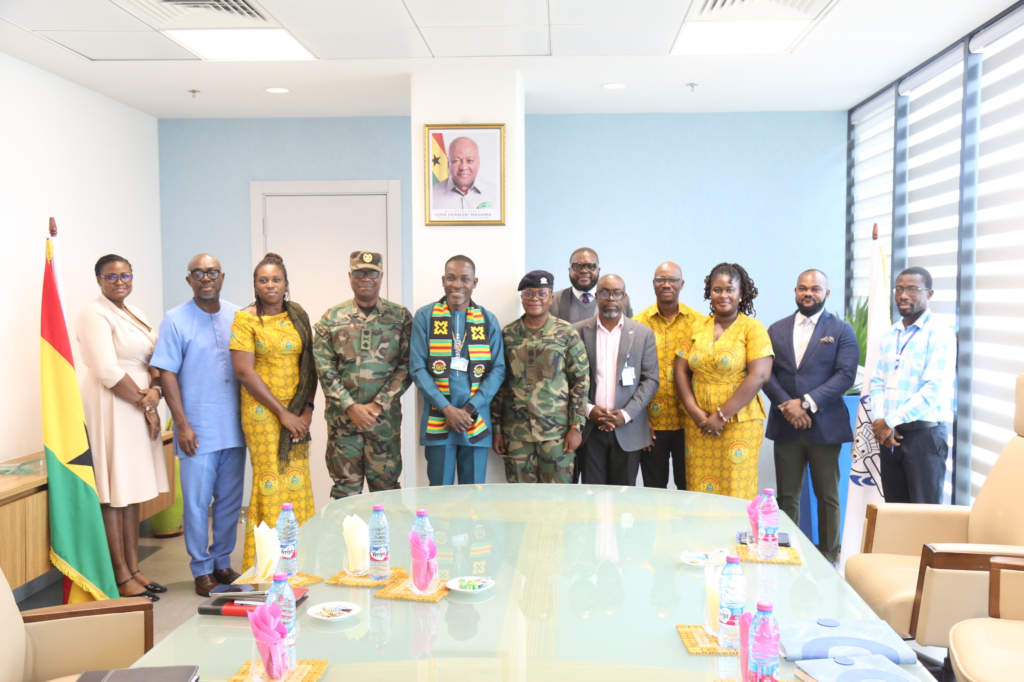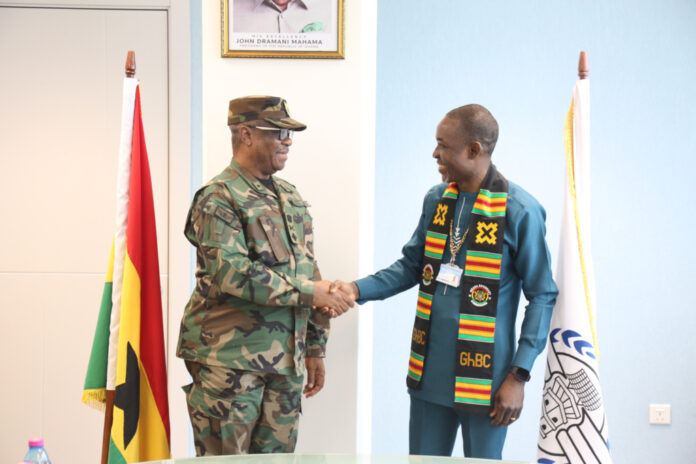The Commissioner-General of the Ghana Boundary Commission, Brigadier General Anthony Ntem, led a delegation to pay a courtesy call on the Ghana Civil Aviation Authority (GCAA) at Kotoka International Airport on Thursday, July 17, 2025.
The purpose of the visit was to formally introduce himself to the Authority and initiate cooperation and collaboration between the two government institutions in handling air boundary matters.
Welcoming the delegation, the Acting Director-General of the GCAA, Rev. Stephen Wilfred Arthur, provided an overview of the Authority’s mandates, which include regulating Ghana’s air transport industry, overseeing economic regulation, and providing air navigation services in the Accra Flight Information Region (FIR).
Rev. Arthur explained that the GCAA gained autonomy in 1986 through the promulgation of PNDC Law 151. This law has undergone several amendments, with the current legislation being Act 1120, passed in 2024.

For his part, Brig. Gen. Ntem expressed appreciation to the Acting Director-General for the insight shared with his team regarding the operations of the GCAA. He noted that the Ghana Boundary Commission was established by Act 795 in 2010, which was repealed and replaced by Act 1123 in 2024.
He outlined the Commission’s functions, stating that they include the delimitation of airspace and the resolution of issues concerning airspace boundaries.
“When we have issues with any other neighbouring country’s airspace boundary, that is when we come in, and Ghana Civil Aviation Authority is one of the members of the Airspace Boundary Technical Committee – which is yet to be formed – so I deemed it fit this morning to come and introduce myself and staff to you, and then going forward, you’ll be collaborating with us on matters regarding airspace boundary issues,”
he said.
Brig. Gen. Ntem further highlighted that, beyond airspace boundaries, the Commission also deals with land and maritime boundary matters.
In response, Rev. Arthur emphasised the importance of the GCAA being familiar with the provisions of the Ghana Boundary Commission’s new Act to enhance mutual collaboration.
“We pledge to be very supportive of your cause because we’re still one government, one nation. We are both under the government’s administration. It’s like being branches of one big tree. We may grow in different directions but come from a common root and stem – that is the nation and government, so, it doesn’t matter how we have fared in the past, we believe that the opportunity exists to work in closer collaboration and I think that from time to time, as we meet and interact more, we’ll be able to know the areas in which we need to collaborate more through programmes, events and activities to learn more about each other’s industry.”
Rev. Arthur added that the visit presents a valuable opportunity to foster stronger engagement and collaboration. He proposed that the two organisations hold biannual meetings to facilitate knowledge-sharing, noting that the GCAA’s strategic outputs could serve as inputs for the Commission.
“So, it is only fair and appropriate that we engage and make things better,”
he stated, adding that through such collaboration, the Commission could help address any issues that may arise concerning the Accra Flight Information Region (FIR).
Rev. Arthur also pointed out that cooperation would support the GCAA in its provision of air navigation services, as the Air Navigation Services (ANS) Division oversees the airside of the airport, the airspace above the aerodrome, and the oceanic space.
He emphasised the need to share protocols and Memoranda of Understanding (MoUs) concerning oceanic air boundaries with the GCAA, given potential scenarios that might require collaboration with the Ghana Maritime Authority, such as search and rescue operations in oceanic airspace.
“Even if something exists in the past, there are new trends and developments that may necessitate it being re-examined as to whether they meet current standards and best practices. So, whether the oceanic side, our own land space, we still must share such information. So, all these details, in terms of the technical demarcations, must be shared so that we can be on the same page as far as information is concerned,” he said.
He assured that the GCAA would make available all relevant technical charts and coordinates of the airspace to the Commission.
Supporting the Acting Director-General’s remarks, the Authority’s Acting Deputy Director-General (Technical), Mr. Theophilus Adonis Aryee Ago, said the GCAA would intensify engagement with the Commission to better understand its airspace demarcation, especially since Ghana shares air boundaries with countries as far as Rwanda.
Mr Ago explained that the airspace has been delineated in such a way that even São Tomé falls within scope, making it essential for the GCAA to have a clear understanding of the Commission’s demarcation to effectively carry out its mandate.
At the end of the meeting, the Commission presented a copy of its new Act to the Ag. DG of GCAA.
DISCLAIMER: The Views, Comments, Opinions, Contributions and Statements made by Readers and Contributors on this platform do not necessarily represent the views or policy of Multimedia Group Limited.
DISCLAIMER: The Views, Comments, Opinions, Contributions and Statements made by Readers and Contributors on this platform do not necessarily represent the views or policy of Multimedia Group Limited.


